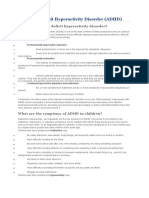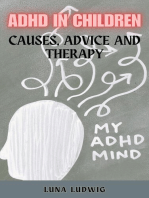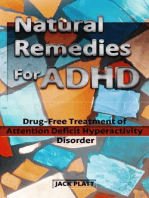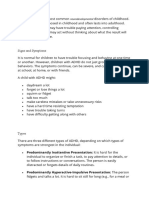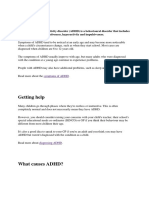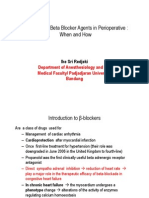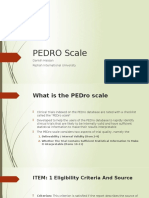Attention Deficit Disorder/ Attention Deficit Hyperactivity Disorder
Attention Deficit Disorder/ Attention Deficit Hyperactivity Disorder
Uploaded by
Lisa Nelson-FriginetteCopyright:
Available Formats
Attention Deficit Disorder/ Attention Deficit Hyperactivity Disorder
Attention Deficit Disorder/ Attention Deficit Hyperactivity Disorder
Uploaded by
Lisa Nelson-FriginetteOriginal Title
Copyright
Available Formats
Share this document
Did you find this document useful?
Is this content inappropriate?
Copyright:
Available Formats
Attention Deficit Disorder/ Attention Deficit Hyperactivity Disorder
Attention Deficit Disorder/ Attention Deficit Hyperactivity Disorder
Uploaded by
Lisa Nelson-FriginetteCopyright:
Available Formats
Attention Deficit Disorder/ Attention Deficit Hyperactivity Disorder Attention-deficit hyperactivity disorder (ADHD), usually first diagnosed in childhood,
can appear in a variety of forms and has many possible causes. People with ADHD probably have an underlying genetic vulnerability to developing it, but the severity of the problem is also influenced by the environment. Conflict and stress tend to make it worse.
The main features of this disorder are found in its name. Attention problems include daydreaming, difficulty focusing and being easily distracted. Hyperactivity refers to fidgeting or restlessness. A person with the disorder may be disruptive or impulsive, may have trouble in relationships and may be accident-prone. Hyperactivity and impulsiveness often improve as a person matures, but attention problems tend to last into adulthood.
Causes of ADHD
Altered brain function and anatomy- While the exact cause of ADHD remains a mystery, brain scans have revealed important differences in the structure and brain activity of people with ADHD. For example, there appears to be less activity in the areas of the brain that control activity levels and attention. Heredity-ADHD tends to run in families. Several genes that may be associated with ADHD are currently being studied.
Maternal smoking, drug use and exposure to toxinsPregnant women who smoke are at increased risk of having children with ADHD. Alcohol or drug abuse during pregnancy may reduce activity of the nerve cells (neurons) that produce neurotransmitters. Pregnant women who are exposed to environmental poisons also may be more likely to have children with symptoms of ADHD. Childhood exposure to environmental toxins -Preschool children exposed to certain toxins are at increased risk of developmental and behavioral problems. Exposure to lead, which is found mainly in paint and pipes in older buildings,
has been linked to disruptive and even violent behavior and to a short attention span.
Food additives- Substances added to food, such as artificial coloring or food preservatives, may contribute to hyperactive behavior. Although sugar is a popular suspect in causing hyperactivity, there's no reliable proof of this.
Symptoms of ADHD There are three different categories of ADHD symptoms: inattention, hyperactivity, impulsivity. Inattention may not become apparent until a child enters the challenging environment of school. In adults, symptoms of inattention may manifest in work or in social situations.
A person with ADHD may have some or all of the following symptoms: difficulty paying attention to details and tendency to make careless mistakes in school or other activities; producing work that is often messy and careless easily distracted by irrelevant stimuli and frequently interrupting ongoing tasks to attend to trivial noises or events that are usually ignored by others inability to sustain attention on tasks or activities difficulty finishing schoolwork or paperwork or performing tasks that require concentration frequent shifts from one uncompleted activity to another procrastination disorganized work habits forgetfulness in daily activities (for example, missing appointments, forgetting to bring lunch) failure to complete tasks such as homework or chores frequent shifts in conversation, not listening to others, not keeping one's mind on conversations, and not following details or rules of activities in social situations
Hyperactivity symptoms may be apparent in very young preschoolers and are nearly always present before the age of seven. Symptoms include: fidgeting, squirming when seated getting up frequently to walk or run around running or climbing excessively when it's inappropriate (in teens this may appear as restlessness)
having difficulty playing quietly or engaging in quiet leisure activities being always on the go often talking excessively Hyperactivity may vary with age and developmental stage. Toddlers and preschoolers with ADHD tend to be constantly in motion, jumping on furniture, and having difficulty participating in sedentary group activities. For instance, they may have trouble listening to a story. School-age children display similar behavior but with less frequency. They are unable to remain seated, squirm a lot, fidget, or talk excessively. In adolescents and adults, hyperactivity may manifest itself as feelings of restlessness and difficulty engaging in quiet sedentary activities. Impulsivity symptoms include: impatience difficulty delaying responses blurting out answers before questions have been completed difficulty awaiting one's turn frequently interrupting or intruding on others to the point of causing problems in social or work settings initiating conversations at inappropriate times
Impulsivity may lead to accidents such as knocking over objects or banging into people. Children with ADHD may also engage in potentially dangerous activities without considering the consequences. For instance, they may climb to precarious positions.
Treatment for ADHD Although no treatment eliminates ADHD completely, many helpful options are available. The goal of treatment is to help children improve social relationships, do better in school, and keep their disruptive or harmful behaviors to a minimum. Medication can be very helpful, and it is often necessary. Drug treatment by itself is
rarely the answer. Medication and psychotherapy together usually have the best results. For example, a behavioral program may be put in place where structured, realistic expectations are set.
Stimulants, such as methylphenidate (Ritalin) and forms of amphetamine (Dexedrine), have been used for many decades. They are relatively safe and effective for most children to help them focus their thoughts and control their behavior. With the development of long-acting forms of stimulants, one dose in the morning can provide a day-long effect.
Despite their name, stimulants do not cause increased hyperactivity or impulsivity. If the disorder has been properly diagnosed, the medication actually has the opposite effect. Common mild side effects are decreased appetite, weight loss, stomachaches, sleep problems, headaches and jitteriness. Adjusting the dose can often help eliminate these problems. Stimulant drugs are associated with some serious concerns and side effects.
Other treatment approaches, used alone or in combination, may include: Behavioral therapy This refers to techniques that try to improve behavior, usually by rewarding and encouraging desirable behaviors and by discouraging unwanted behaviors and pointing out the consequences.
Cognitive therapy This is psychotherapy designed to change thinking to build self-esteem, stop having negative thoughts and improve problem-solving skills. Social skill training Developing social skills improves friendships. Parent education and support Training classes, support groups and counselors can help to teach and support parents about ADHD, including strategies for dealing with ADHDrelated behaviors. Because many children with ADHD also are troubled by poor grades and school behavior problems, schools may need to provide educational adjustments and interventions (such as an individualized educational plan) to promote the best possible learning environment for the child.
Prognosis ADHD can cause significant emotional, social and educational problems. However, when ADHD is diagnosed early and treated properly, the condition can be managed effectively, so children can grow up to have productive, successful and fulfilling lives. Although
some children appear to grow out of their ADHD as they reach their adolescent years, others have lifelong symptoms.
Dyslexia Dyslexia is the most common learning disability. It is a specific learning disability that is neurological in origin. Dyslexia is characterized by difficulties with accurate
and/or fluent word recognition and by poor spelling and decoding abilities.
These difficulties typically result from a deficit in the phonologic component of language that is often unexpected in relation to other cognitive abilities and the provision of effective classroom instruction. Secondary consequences may include problems in reading comprehension and reduced reading experience that can impede the growth of vocabulary and background knowledge.
Someone with dyslexia has trouble reading and writing even though he or she has the intelligence and motivation needed to learn to read. Although people with dyslexia have trouble understanding words they read, they usually can understand the same words when they are read aloud by another person.
Causes of Dyslexia There are three main types of dyslexia that can affect the child's ability to spell as well as read. Each type of dyslexia
has a different cause. The three main types are trauma dyslexia, primary dyslexia and developmental dyslexia. Trauma dyslexia usually occurs after some type of brain trauma or injury to the area of the brain that controls reading and writing. This type of dyslexia is rarely seen in today's school-age population. Primary dyslexia is a dysfunction of, rather than damage to, the left side of the brain (cerebral cortex) and does not change with maturity. Individuals with this type are rarely able to read above a fourth grade level and may struggle with reading, spelling, and writing as adults. Primary dyslexia is hereditary and is found more often in boys than in girls. The difference between primary dyslexia and trauma dyslexia is that trauma dyslexia occurs after a brain trauma and primary dyslexia is a dysfunction of the brain. Developmental dyslexia is caused by hormonal development during the early stages of fetal development. Developmental dyslexia diminishes as the child matures. This type is also more common in boys.
Symptoms of Dyslexia
Struggles learning the alphabet Exhibits speech and language problems Lacks understanding of rhyming words Struggles associating a sound with its written symbol Skips words or puts in extra words when reading Changes words when reading Guesses wildly at words Reads a word correctly several times on a page, but then forgets it in seconds Reads slowly and with great difficulty Knows too few words for his age and grade level Comprehends poorly Comprehends well but difficulty with decoding Cries or becomes upset when asked to read
Treatment for Dyslexia
Several techniques and strategies are used to help people with dyslexia. These include taping lectures rather than writing notes, listening to books on tape rather than reading them, using flash cards, and using computer software to check spelling and grammar.
Treatment may involve time spent with speech and language therapists, tutors, and special education teachers. With support, most children with dyslexia adjust to their learning disability and remain in a regular classroom. Some may require special education.
Prognosis
Most children with dyslexia can do well academically and professionally, despite the fact that dyslexia is a lifelong disability. The outlook for each child with dyslexia depends on how severe the disability is, how early it is diagnosed and the quality of the treatment.
Autism Autism is known as a complex developmental disability. It presents itself before the age of three and is characterized
by impaired verbal and non-verbal communication, social interaction, some form of repetitive and restricted stereotyped interest, ritual, or other behavior during the early stage of a childs life. This condition is the result of a neurological disorder.
Causes of Autism Autism has no single, known cause. Given the complexity of the disease, the range of autistic disorders and the fact that no two children with autism are alike, there are likely many causes. These may include: Genetic problems. A number of genes appear to be involved in autism. Some may make a child more susceptible to the disorder; others affect brain development or the way brain cells communicate. Still others may determine the severity of symptoms. Each problem in genes may account for a small number of cases, but taken together, the influence of genes may be substantial. Some genetic problems seem to be inherited, whereas others happen spontaneously. Environmental factors. Many health problems are due to both genetic and environmental factors, and this is likely the case with autism as well. Researchers are currently exploring whether viral infections and air
pollutants, for example, play a role in triggering autism. Autism affects males four times more often than females, and there is a genetic basis for the disease.
Symptoms of Autism Children with autism generally have problems in three crucial areas of development social interaction, language
and behavior. But because autism symptoms vary greatly, two children with the same diagnosis may act quite differently and have strikingly different skills. In most cases, though, severe autism is marked by a complete inability to communicate or interact with other people. Some children show signs of autism in early infancy. Other children may develop normally for the first few months or years of life but then suddenly become withdrawn, become aggressive or lose language skills they've already acquired. Though each child with autism is likely to have a unique pattern of behavior, these are some common autism symptoms:
Social skills Fails to respond to his or her name Has poor eye contact Appears not to hear you at times Resists cuddling and holding Appears unaware of others' feelings Seems to prefer playing alone retreats into his or her "own world" Language Starts talking later than age 2, and has other developmental delays by 30 months
Loses previously acquired ability to say words or sentences Doesn't make eye contact when making requests Speaks with an abnormal tone or rhythm may use a singsong voice or robot-like speech Can't start a conversation or keep one going May repeat words or phrases verbatim, but doesn't understand how to use them Behavior Performs repetitive movements, such as rocking, spinning or hand-flapping Develops specific routines or rituals Becomes disturbed at the slightest change in routines or rituals Moves constantly May be fascinated by parts of an object, such as the spinning wheels of a toy car May be unusually sensitive to light, sound and touch and yet oblivious to pain Treatment for Autism There is no cure for autism; however, with appropriate treatment and education, many children with the disorder can learn and develop. Early intervention often can reduce
challenges associated with the disorder, lessen disruptive behavior, and provide some degree of independence. Treatment depends on the individual needs of the patient. In most cases, a combination of treatment methods is more effective. Autism usually requires lifelong treatment. Occupational therapy and physical therapy are sometimes used to treat autism. Occupational therapy helps improve independent function and teaches basic skills (e.g., buttoning a shirt, bathing). Physical therapy involves using exercise and other physical measures (e.g., massage, heat) to help patients control body movements. Autism treatment includes the following: Behavior Modification There are several methods of behavior modification that are used to treat inappropriate, repetitive, and aggressive behavior and to provide autistic patients with skills necessary to function in their environment. Most types of behavior modification are based on the theory that rewarded behavior is more likely to be repeated than behavior that is ignored. This theory is called applied behavior analysis (ABA). Behavior modification often involves highly structured, skill-oriented activities that are based on the patient's needs and interests. It usually requires intense, one-on-one training with a therapist and extensive caregiver involvement.
Sensory integration therapy is a type of behavior modification that focuses on helping autistic patients cope with sensory stimulation. Treatment may include having the patient handle materials with different textures or listen to different sounds. Social interaction is often affected by limited emotional development that is common in autistic patients. Play therapy is a type of behavior modification that is used to improve emotional development, which in turn, improves social skills and learning. Play therapy involves adult-child interaction that is controlled by the child. Social stories can also be used to improve undeveloped social skills. Stories are designed to help autistic patients understand the feelings, ideas, and points of view of others, or to suggest an alternate response to a particular situation. They also may be used to help patients understand and cope with their own feelings. Behavioral therapists can teach caregivers how to develop social stories.
Communication Therapy Communication therapy is used to treat autistic patients who are unable to communicate verbally, or to initiate language development in young children with the
disorder. Speech therapy may be used to help patients gain the ability to speak. Picture exchange communication systems (PECS) enable autistic patients to communicate using pictures that represent ideas, activities, or items. The patient is able to convey requests, needs, and desires to others by simply handing them a picture. Dietary Modifications Autism is not caused by diet and the use of dietary modifications and supplements to treat the disorder is controversial. Changing the diet or adding vitamin supplements may improve digestion and eliminate food intolerances or allergies, which may contribute to behavioral problems in autistic patients. Researchers have found elevated levels of proteins found in wheat, oats and rye (gluten) and casein (protein in dairy products) byproducts in patients with autism, suggesting that the incomplete breakdown or excessive absorption of these substances may affect brain function. Eliminating foods that contain gluten and casein from the diet may cause side effects and should not be done without the advice of a health care practitioner. Medications There is not one drug that treats all symptoms of autism effectively. Medications that may be considered include:
Antipsychotic medications to reduce aggression, irritability and repetitive behavior. These medications also have unwanted side effects. Antidepressants to treat depression and repetitive behaviors. Anti-anxiety medications for anxiety-related behavior. Central nervous system stimulants to treat hyperactive or impulsive behavior.
Prognosis
The difficult behaviors seen in autistic toddlers tend to improve between ages 6 and 10. Problems may resurface during the teen and young adult years. They eventually calm down again in middle and later life. Some children with autism are able to live independently. Others may struggle to maintain normal social interactions, communication and behaviors. Experts believe earlier ASD diagnosis and treatment leads to a better outcome. Life expectancy depends on whether the person has other conditions and the person's overall health.
You might also like
- Intern Survival Guide: DisclaimerDocument23 pagesIntern Survival Guide: DisclaimerKing David100% (1)
- Reflection Paper About ADHDDocument3 pagesReflection Paper About ADHDIvy Sicabalo100% (1)
- Autonomic Nervous System Drugs Simple Complement Type QuestionsDocument11 pagesAutonomic Nervous System Drugs Simple Complement Type QuestionsIrina Panciu Stefan100% (2)
- Study of Coagulable and Non Coagulable Milk ProteinsDocument9 pagesStudy of Coagulable and Non Coagulable Milk ProteinsMainak Sarkar73% (22)
- What Are The Different Types of ADHD?Document6 pagesWhat Are The Different Types of ADHD?Edgar GilNo ratings yet
- ADHDDocument3 pagesADHDLaveeza KhurramNo ratings yet
- Infographic Developmental DisorderDocument13 pagesInfographic Developmental DisorderNaomi KristianaNo ratings yet
- Attention Deficit Hyperactivity DisorderDocument3 pagesAttention Deficit Hyperactivity DisorderMuhammad FikrieNo ratings yet
- Developmental Psychopathology CP-2 - 223377 (Himanshi Lahora) MA Psychology Sem 4Document9 pagesDevelopmental Psychopathology CP-2 - 223377 (Himanshi Lahora) MA Psychology Sem 4Himanshi LahoraNo ratings yet
- What Is Attention Deficit Hyperactivity DisorderDocument11 pagesWhat Is Attention Deficit Hyperactivity DisorderChris InocencioNo ratings yet
- Attention Deficit Hyperactivity Disorder-1-1Document15 pagesAttention Deficit Hyperactivity Disorder-1-1Anonymous IfgqyCrtwWNo ratings yet
- Attention Deficit-Hyperactive DisorderDocument3 pagesAttention Deficit-Hyperactive Disorderadan oladiveNo ratings yet
- AdhdDocument3 pagesAdhdMaria Erika Corachea RamosNo ratings yet
- ADHDDocument8 pagesADHDolaniyiolabanjo5No ratings yet
- Detachment - What Is AdhdDocument3 pagesDetachment - What Is AdhdFlor AmarilloNo ratings yet
- ADHDDocument4 pagesADHDAlina Alexandru100% (1)
- Adhd - Newsletter 1Document4 pagesAdhd - Newsletter 1api-344792702No ratings yet
- ADD/ADHDDocument18 pagesADD/ADHDmedhamindbftpNo ratings yet
- Acute Deficit Hyperactive DisorderDocument36 pagesAcute Deficit Hyperactive DisorderjackleenNo ratings yet
- Autism and Adhd 1,222Document4 pagesAutism and Adhd 1,222NJ BesanaNo ratings yet
- Neurodevelopmental Disorders ADHDDocument40 pagesNeurodevelopmental Disorders ADHDTrisha Mae MarquezNo ratings yet
- ADHDDocument2 pagesADHDMerijn MattheijssenNo ratings yet
- Adhd 1Document15 pagesAdhd 1DayangFauziah Bt AwangAhetNo ratings yet
- Adhd - Zainab HyderabadwalaDocument5 pagesAdhd - Zainab HyderabadwalazainabNo ratings yet
- Clinical Case Analysis AdhdDocument5 pagesClinical Case Analysis AdhdSiobhan GreeneNo ratings yet
- Different Behavioral ProblemsDocument42 pagesDifferent Behavioral ProblemsCJ Ramat AjeroNo ratings yet
- A Guide On ADHD Using Neural ConnectionsDocument13 pagesA Guide On ADHD Using Neural ConnectionsNehad BalochNo ratings yet
- Raquelyn J. Bernal, DDC PT-Intern What Is Attention Deficit Hyperactivity Disorder?Document3 pagesRaquelyn J. Bernal, DDC PT-Intern What Is Attention Deficit Hyperactivity Disorder?blah blah yah yahNo ratings yet
- Attention Deficit Hyperactivity DisorderDocument5 pagesAttention Deficit Hyperactivity DisorderPugsley AddamsNo ratings yet
- Educ 111 AssDocument2 pagesEduc 111 Asslames albertoNo ratings yet
- Attention Deficit Hyperactivity DisorderDocument9 pagesAttention Deficit Hyperactivity DisorderNurjahan FerdousiNo ratings yet
- ADHD In Adults: Am I ADHD? Interactive Questions For ADHD Assessment: Learn If You Suffer From ADHD - Take This Assessment TestFrom EverandADHD In Adults: Am I ADHD? Interactive Questions For ADHD Assessment: Learn If You Suffer From ADHD - Take This Assessment TestNo ratings yet
- Case Study Psychia AdhdDocument53 pagesCase Study Psychia AdhdMilagros FloritaNo ratings yet
- Attention Deficit Hyperactivity DisorderDocument4 pagesAttention Deficit Hyperactivity DisordergaggleboreNo ratings yet
- ADHD, Special InstitutionDocument16 pagesADHD, Special InstitutionRan DellNo ratings yet
- Attention Deficit Hyperactivity DisorderDocument4 pagesAttention Deficit Hyperactivity DisorderThata Thata100% (1)
- Attention Deficit Activity Disorder 2Document8 pagesAttention Deficit Activity Disorder 2shashikala meedeniyaNo ratings yet
- Parents Guide To ADHD in ChildrenDocument12 pagesParents Guide To ADHD in Childrencatia cafeNo ratings yet
- FH081011 022Document1 pageFH081011 022Aldo NahedNo ratings yet
- 49Document2 pages49yersaiyn.kairzhanovNo ratings yet
- AdhdDocument4 pagesAdhdSabrina Alam MrittikaNo ratings yet
- Adhd TalaDocument4 pagesAdhd TalaAgus BarretoNo ratings yet
- Adult ADHD: Understanding adult ADHD and how to manage, treat, and improve itFrom EverandAdult ADHD: Understanding adult ADHD and how to manage, treat, and improve itRating: 5 out of 5 stars5/5 (1)
- Understanding Child DevelopmentDocument11 pagesUnderstanding Child DevelopmentcathyNo ratings yet
- Gut microbiome in ADHD and nutraceuticals' efficacyDocument7 pagesGut microbiome in ADHD and nutraceuticals' efficacyagelikiNo ratings yet
- Attention Deficit Hyperactivity DisorderDocument8 pagesAttention Deficit Hyperactivity DisorderShinjiNo ratings yet
- Presentation 1Document13 pagesPresentation 1Daniar AtaNo ratings yet
- ADHDDocument23 pagesADHDNARUTONo ratings yet
- ADHD Quick Fact Sheet For Parents Guardians and School PersonnelDocument2 pagesADHD Quick Fact Sheet For Parents Guardians and School Personnelinetwork2001No ratings yet
- M.G.D Girls' School SESSION 2014-15 Psychology Project ON Attention Deficit Hyperactive DisorderDocument22 pagesM.G.D Girls' School SESSION 2014-15 Psychology Project ON Attention Deficit Hyperactive DisordersnehalNo ratings yet
- Colorful Organic Child Psychology PresentationDocument9 pagesColorful Organic Child Psychology Presentationkemillyaquino533No ratings yet
- ADHD, Autism, LD, Intellectual DisabilityDocument8 pagesADHD, Autism, LD, Intellectual Disabilityteenajohns2512No ratings yet
- Neurodiversity and Co-Occurring DifferencesDocument4 pagesNeurodiversity and Co-Occurring DifferencesNosparesNo ratings yet
- ADHD Pre-Referral InformationDocument11 pagesADHD Pre-Referral InformationjalejandropinedagNo ratings yet
- Childhoodmentaldx - Copy1234Document32 pagesChildhoodmentaldx - Copy1234shafi ullahNo ratings yet
- Attention-Deficit/ Hyperactivity Disorder in Children and TeensDocument8 pagesAttention-Deficit/ Hyperactivity Disorder in Children and TeensPaula LaraNo ratings yet
- The University of The West Indies Cave Hill Campus: TO Dr. George MahyDocument6 pagesThe University of The West Indies Cave Hill Campus: TO Dr. George MahyKala ArchieNo ratings yet
- Nero Developmental Disorder NotesDocument16 pagesNero Developmental Disorder Notesemotionocean101No ratings yet
- Types of Disorder, Its Cause & Nature (Adhd, SPD, Asd, Odd, Ocd)Document16 pagesTypes of Disorder, Its Cause & Nature (Adhd, SPD, Asd, Odd, Ocd)riha mogNo ratings yet
- FAQ's by Parents of CWDDocument15 pagesFAQ's by Parents of CWDMarielou MendonzaNo ratings yet
- Child psychologyDocument9 pagesChild psychologyrojejo8918No ratings yet
- Diabetes and ExerciseDocument5 pagesDiabetes and ExerciseRoslitha HaryaniNo ratings yet
- The West Bengal University of Health SciencesDocument22 pagesThe West Bengal University of Health SciencesAditya RanjanNo ratings yet
- Beta Blocker AgentsDocument28 pagesBeta Blocker Agentskuncupcupu1368No ratings yet
- Page 1 of 33Document33 pagesPage 1 of 33KirubakaranNo ratings yet
- Shrinkage of Endodontic SealersDocument2 pagesShrinkage of Endodontic Sealersdr.samiNo ratings yet
- Iavt03i3p89 PDFDocument3 pagesIavt03i3p89 PDFTisna WennyNo ratings yet
- PG Medical Entrance Practice QuestionsDocument12 pagesPG Medical Entrance Practice QuestionsGradestackNo ratings yet
- Therapeutic Community Program - ResearchDocument6 pagesTherapeutic Community Program - ResearchCamille Kristine DionisioNo ratings yet
- Critical Care Patients at Risk For Medical ErrorsDocument1 pageCritical Care Patients at Risk For Medical ErrorsRay-ann SorillaNo ratings yet
- StinaDocument5 pagesStinaKaaya GodfreyNo ratings yet
- Management of Sacral Dimples Detected On Routine Newborn Examination: A Case Series and ReviewDocument3 pagesManagement of Sacral Dimples Detected On Routine Newborn Examination: A Case Series and ReviewDesta FransiscaNo ratings yet
- Intraoral RadiographicDocument62 pagesIntraoral RadiographicEuginiaNo ratings yet
- SDA WorkflowsDocument6 pagesSDA WorkflowsYu En CheahNo ratings yet
- Roll No. 107 Rajvardhan Singh SolankiDocument2 pagesRoll No. 107 Rajvardhan Singh SolankiSurya pratap SinghNo ratings yet
- Assessment in Psychotherapy - Judy CooperDocument137 pagesAssessment in Psychotherapy - Judy Cooperrizgar hassanNo ratings yet
- Fruit or Vegetable, It's All About Fair Pay: Budget Cuts Threaten ClasDocument14 pagesFruit or Vegetable, It's All About Fair Pay: Budget Cuts Threaten ClasThe University Daily KansanNo ratings yet
- Open Access Protocol: To Cite: Withers HG, Glinsky JVDocument8 pagesOpen Access Protocol: To Cite: Withers HG, Glinsky JVlabsoneducationNo ratings yet
- Sharon Denise Gross: 513 Grazing Field Drive, Tuscaloosa, AL 35405 (C) 205-242-3670 (W) 205-554-2000 Ext. 3617 (E) (E)Document6 pagesSharon Denise Gross: 513 Grazing Field Drive, Tuscaloosa, AL 35405 (C) 205-242-3670 (W) 205-554-2000 Ext. 3617 (E) (E)api-469030612No ratings yet
- The Discipline of Social Work: Welcome!Document11 pagesThe Discipline of Social Work: Welcome!Sha CalsesNo ratings yet
- RanitidineDocument1 pageRanitidineAyeNo ratings yet
- Pedro ScaleDocument15 pagesPedro ScaleAsad Chaudhary100% (2)
- Historical Development Profession of Pharmacy and Pharmacutical IndustryDocument26 pagesHistorical Development Profession of Pharmacy and Pharmacutical IndustrySuresh Thanneru25% (4)
- Fluids and Electrolytes SP 09Document119 pagesFluids and Electrolytes SP 09Amy100% (8)
- Ahfs Essentials User GuideDocument4 pagesAhfs Essentials User GuidenhuynguyengocNo ratings yet
- Jospt 2018Document1 pageJospt 2018Osvaldo Loperena LopezNo ratings yet
- What To Do If Force VaccinatedDocument8 pagesWhat To Do If Force Vaccinated6bogota9100% (5)
- Eat 23121Document9 pagesEat 23121Ma José EstébanezNo ratings yet







